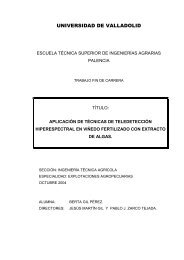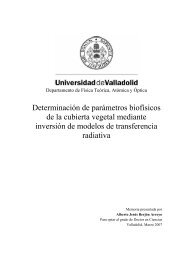10th INTERNATIONAL VERTICILLIUM SYMPOSIUM 16-20 ...
10th INTERNATIONAL VERTICILLIUM SYMPOSIUM 16-20 ...
10th INTERNATIONAL VERTICILLIUM SYMPOSIUM 16-20 ...
You also want an ePaper? Increase the reach of your titles
YUMPU automatically turns print PDFs into web optimized ePapers that Google loves.
CULTIVAR-SPECIFIC PSEUDOMONAS COMMUNITIES IN THERHIZOSPHERE OF OLIVE TREESKATJA DROFENIGG 1 , SERGIO ARANDA 2 , BLANCA B. LANDA 2 ,GABRIELE BERG 1 AND HENRY MÜLLER 11 Institute of Environmental Biotechnology, Graz University of Technology, Graz, Austria;2 Institute of Sustainable Agriculture (IAS), CSIC, P.O. Box 4084, 14080 Córdoba, SpainBacteria from the genus Pseudomonas represent ubiquitous plant colonizer withdistinct ability to antagonize fungal pathogens. This includes Verticillium dahliae adevastating pathogen causing dramatic damages in olive orchards across theMediterranean region. Along with a study analyzing the cultivar specificity ofrhizosphere-associated microbial communities, we drew special attention toPseudomonas populations. Overall, <strong>16</strong> cultivars from different origins but grown atthe same site in Andalusia, Spain, were studied. Rhizosphere samples from four treeseach cultivar were analyzed applying a multiphasic approach including cultivationdependentand –independent methods. Using the Most Probable Number (MPN)method with selective media, we observed 3 x 10 4 to 2 x 10 6 of culturablepseudomonads per gram root fresh weight. In addition to cultivation, Pseudomonasabundances were determined by quantitative Real-Time PCR from a total DNAextract. Structural as well as functional diversity of root-associated Pseudomonascommunities was studied employing the fingerprint technique Single-Strand-Conformation-Polymorphism (SSCP) analysis based on <strong>16</strong>S rDNA sequences and2,4-diacetylphloroglucinol synthesis genes.Although investigated olive cultivars were grown and managed at the same site,results indicate a significant cultivar and even an origin-specific colonization bypseudomonads. These findings could support development of plant protectionstrategies against Verticillium wilt by means of biological control agents.108




